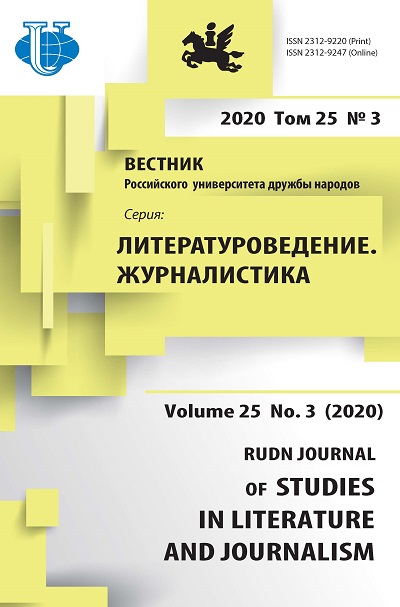Gogol’s traditions in V. Kaverin’s novel “The Troublemaker, or Evenings on Vasilyevsky Island”
- Authors: Koltsova N.Z.1, Liu M.1
-
Affiliations:
- Lomonosov Moscow State University
- Issue: Vol 25, No 3 (2020)
- Pages: 434-446
- Section: LITERARY CRITICISM
- URL: https://journals.rudn.ru/literary-criticism/article/view/24820
- DOI: https://doi.org/10.22363/2312-9220-2020-25-3-434-446
Cite item
Full Text
Abstract
The novel “The Troublemaker, or Evenings on Vasilyevsky Island” by V. Kaverin is one of the most representative manifestations of the “Russian Hoffmanian” of the 1920s, as evidenced by the grotesque imagery of the novel. The very understanding of the grotesque is not limited to the Bakhtin theory, but implies a reference to the works of V. Kaiser and V. Shklovsky. Besides, it is suggested that the Saint Petersburg theme, which is relevant to the writer, is being developed under the banner of the formalist concept of literary life, as well as other ideas and theories of Russian formalism (including the theory of alienation). Kaverin succeeds in putting not only literature itself into the context of the Saint Petersburg myth, but also literature studies, which makes it possible to talk about the work as one of the brightest embodiments of the “philological novel”, the most important characteristic of which is the accentuated intertextual beginning. The work asserts that motives and themes, images and details, syntactic constructions, and even a composition (including a chronotope) of V. Kaverin’s first novel fits into Gogol’s system of coordinates. The Kaverin’s text is a construction assembled from fragments and details of Gogol’s text according to Gogol’s own rules.
Keywords
About the authors
Natalia Z. Koltsova
Lomonosov Moscow State University
Author for correspondence.
Email: kotsovaru@rambler.ru
Candidate of Philological Sciences, Associate Professor at the Department of Modern Russian Literature and Contemporary Literary Process of the Faculty of Philology
1 Leninskie Gory, bldg 51, Moscow, 119991, Russian FederationMiaowen Liu
Lomonosov Moscow State University
Email: miaowenliu@mail.ru
Ph.D. student of the Department of Modern Russian Literature and Contemporary Literary Process of the Faculty of Philology
1 Leninskie Gory, bldg 51, Moscow, 119991, Russian FederationReferences
- Clark, K. (1981). The Soviet Novel: History as Ritual. Chicago, London, The University of Chicago Press.
- Skandura, C. (n.d.). Zdes' chital ad"yunkt-professor Nikolai Vasil'evich Gogol'-Yanovskii (Zametki na polyakh romana V. Kaverina “Skandalist, ili Vechera na Vasil'evskom ostrove”) [Adjunct Professor Nikolai Vasilievich Gogol-Yanovsky read here (Notes on the Fields of the novel by V. Kaverina “The Scandalist, or Evenings on Vasilyevsky Island”)]. Retrieved May 2, 2020, from http://sites.utoronto.ca/tsq/30/skandura30.shtml
- Kaverin, V.A. (1922). Serapionovy brat'ya o sebe: V. Kaverin [Serapionov brothers about themselves: V. Kaverin]. Literaturnye zapisi [Literary records], (3), 25–31.
- Kaverin, V.A. (1983). Sobranie sochinenii [Collection of works] (vol. 8). Moscow, Khudozhestvennaya literatura Publ.
- Mann, Yu.V. (1976). Poetika Gogolya [Poetics of Gogol]. Moscow, Khudozhestvennaya literatura.
- Mann, Yu.V. (1989). Gogol. Istoriya vsemirnoi literatury [Gogol. History of World Literature] (vol. 6, pp. 360–384). Moscow, IMLI AN SSSR Publ.
- Derjurov, A.S. (1996). Grotesk v nemetskoi literature XVIII veka [Grotesque in 18th century German literature] (Dissertation of the Candidate of Philological Sciences). Moscow, MPGU Publ.
- Kaverin, V.A. (1980). Sobranie sochinenii [Collection of works] (vol. 1). Moscow, Khudozhestvennaya literatura Publ.
- Gogol, N.V. (1959). Sobranie sochinenii. T. 3. Povesti [Collection of works. Vol. 3. Stories]. Moscow, Goslytizat Publ.
- Gogol, N.V. (1959). Sobranie khudozhestvennykh proizvedenii. T. 5. Mertvye dushi [Collection of artistic works. Vol. 5. Dead Souls]. Moscow, Izd-vo Akademii nauk SSSR Publ.
- Uspensky, B.A. (1970). Poetika kompozitsii (struktura khudozhestvennogo teksta i tipologiya kompozitsionnoi formy) [Poetics of composition (structure of artistic text and typology of compositional form]. Moscow, Iskusstvo Publ.
- Neklyudova, O.A. (2017). K voprosu o kinematograficheskoi tekhnike v proze V. Kaverina 1920-kh gg. [On the question of cinematographic technique in V. Kaverin's prose of the 1920s]. Siberian Philological Journal, (1), 71–82.
- Skorospelova, E.B. (2003). Russkaya proza XX veka. Ot A. Belogo (“Peterburg”) do B. Pasternaka (“Doktor Zhivago”) [Russian Prose of the 20th Century. From A. Belyy (“Petersburg”) to B. Pasternak (“Doctor Zhivago”)]. Moscow, TEIS Publ.
- Khanzen-Leve Oge, A. (2001). Russkii formalism. Metodologicheskaya rekonstruktsiya razvitiya na osnove printsipa ostraneniya [Russian formalism. Methodological reconstruction of development based on the principle of exclusion]. Moscow, Yazyki russkoi kul'tury Publ.
- Tynyanov, Y.N. (1924). Problema stikhotvornogo yazyka [Problem of Poetic Language]. Leningrad, Academia Publ.
- Vaginov, K.K. (1989). Kozlinaya pesnya. Zabytaya kniga [Goat song. Forgotten Book]. Leningrad, Izd-vo pisatelei v Leningrade Publ.
- Mandelstam, O.E. (2009). Polnoe sobranie sochinenii i pisem. T. 1. Stikhotvoreniya [Complete collection of essays and letters. Vol. 1. Poems]. Moscow, Progress-Pleyada Publ.
- Kataev, V.P. (1978). Almaznyi moi venets [My diamond crown]. Moscow, Prospekt Publ.
















